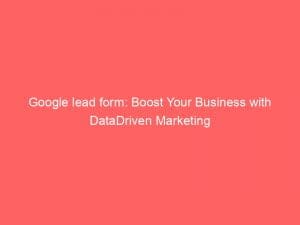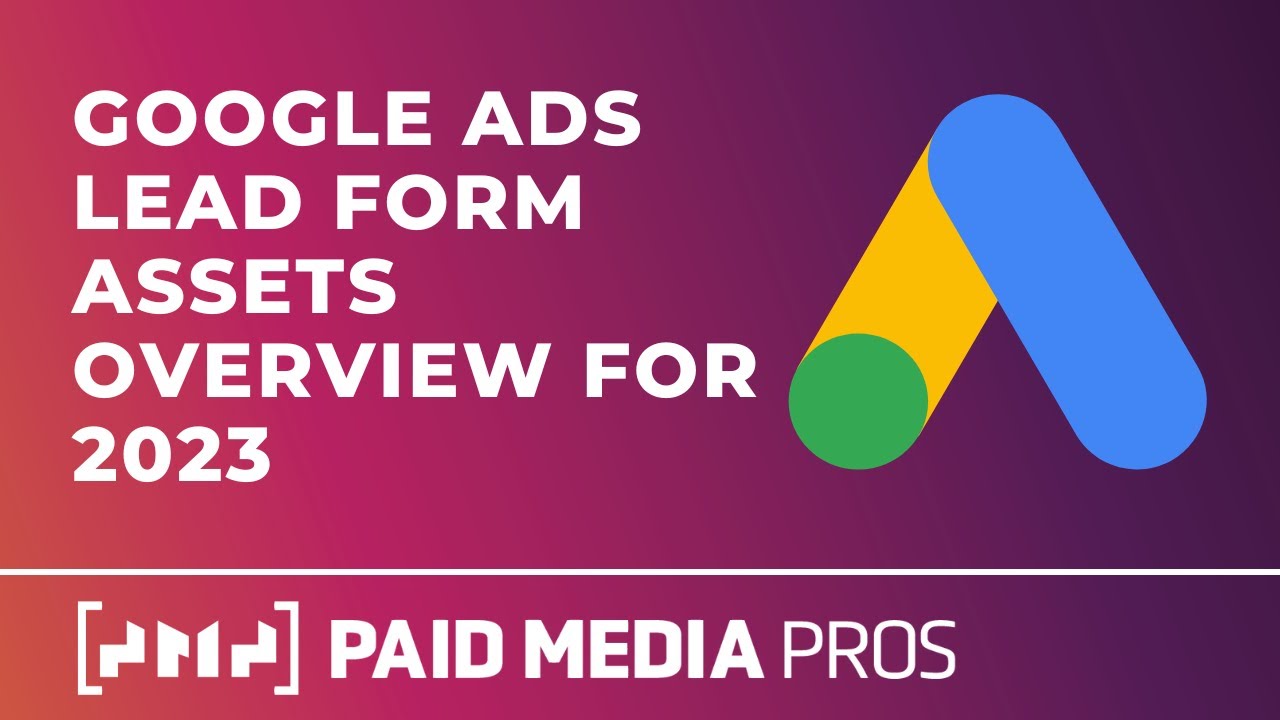In today’s fast-paced digital world, businesses are constantly seeking innovative ways to generate leads and drive sales. One powerful tool that has gained immense popularity is the GoogleLeadForm Extension.
This versatile feature allows businesses to create customizable lead forms that can be seamlessly integrated into various types of campaigns. Whether you’re running a search, display, or video campaign, the Google Lead Form Extension opens up endless possibilities for capturing qualified leads and boosting your bottom line.
However, as with any tool, there are limitations and requirements that need to be considered for optimal use. Join us as we explore the exciting world of Google Lead Form Extensions and uncover the secrets to harnessing their full potential.
Table of Contents
- google lead form
- 1. Lead Form Extensions Now Available Across Search, YouTube, and Discovery Campaigns
- 2. Customize Lead Forms With Over 50 Available Questions
- 3. Set Up Webhook Integrations to Send Leads Directly to CRM Systems
- 4. Lead Form Extensions for Display Ads Coming in the Next Year
- 5. Add Lead Forms to Various Campaign Types: Search, Video, Discovery, and Display
- 6. Eligibility Requirements and Policy Compliance for Using Lead Forms
- 7. Privacy Policy and Specific Requirements for Lead Forms in Different Campaign Types
- 8. Benefits of Lead Forms in Generating Leads, Driving Sales, and Engaging Customers in Google Ads Campaigns
google lead form
A Google lead form is a customizable form that businesses can add to their Google Ads campaigns to generate leads, drive sales, and engage potential customers. These lead forms can be added to various types of campaigns, including Search, Video, Discovery, and Display.
Businesses have the flexibility to customize the lead forms with over fifty available questions and can even add their own questions. To ensure smooth lead management, businesses can set up webhook integrations to automatically send leads to CRM systems.
However, it is important to note that businesses need a history of policy compliance and a Google Ads account in an eligible vertical or sub-vertical to use lead forms. Lead forms require a privacy policy and specific requirements may apply for certain campaign types.
It is also worth mentioning that there are two types of lead forms: “More volume” and “More qualified,” allowing businesses to optimize for more or higher-quality leads. Overall, the Google lead form feature offers businesses a convenient way to gather leads, streamline lead management, and maximize the effectiveness of their Google Ads campaigns.Key Points:
- Google lead forms are customizable forms used in Google Ads campaigns to generate leads, drive sales, and engage potential customers.
- These forms can be added to different types of campaigns like Search, Video, Discovery, and Display.
- Businesses can customize lead forms with over 50 available questions and add their own.
- Webhook integrations can be set up to automatically send leads to CRM systems for easy lead management.
- Compliance with policies and eligibility in a vertical or sub-vertical is required to use lead forms.
- There are two types of lead forms: “More volume” and “More qualified” to optimize for quantity or quality of leads.
Sources
https://support.google.com/google-ads/answer/9423234?hl=en-AU
https://support.google.com/google-ads/answer/10283862?hl=en
https://leadsbridge.com/blog/google-lead-form-ads/
https://support.google.com/google-ads/answer/10014398?hl=en
Check this out:
? Pro Tips:
1. When setting up a lead form integration with your CRM, make sure to generate a webhook URL and key to ensure a secure connection between Google Ads and your CRM system.
2. To optimize for either more volume or more qualified leads, you can change the lead form type in your campaign settings. This allows you to tailor your lead generation strategy and target specific audience segments.
3. Remember to include a privacy policy in your lead form. This is a requirement and helps build trust with potential customers by letting them know their information will be securely handled.
4. Consider adding a background image to your lead form. Visuals can enhance the overall appeal and engagement of your form, potentially encouraging more users to submit their information.
5. Only one lead form asset can be added at the account level. If you need to make changes to an existing lead form, you may need to create a new form with different options instead of directly editing the existing one.
1. Lead Form Extensions Now Available Across Search, YouTube, and Discovery Campaigns
Google has recently announced that lead form extensions are now shareable across Search, YouTube, and Discovery campaigns.
Latest benchmarks updated for programmatic media planners.
This means that businesses can now reach a wider audience and generate more leads by utilizing lead forms in their advertising campaigns on these platforms. This is a significant development that opens up new opportunities for businesses to engage potential customers and drive sales.
With this update, businesses can customize their lead forms with over fifty available questions. This allows them to gather the specific information they need from potential customers, making the lead generation process more targeted and efficient.
By asking relevant questions, businesses can qualify leads and tailor their marketing strategies accordingly, ensuring that they reach the right audience with the right message.
2. Customize Lead Forms With Over 50 Available Questions
The ability to customize lead forms with over fifty available questions gives businesses the flexibility to ask the right questions and gather the necessary information from potential customers.
This customization feature provides businesses with valuable insights and allows them to target their marketing efforts more effectively.
By adding their own questions, businesses can gather specific information that is relevant to their products or services. This helps them understand their target audience better and create personalized marketing campaigns that resonate with potential customers.
The customization options ensure that businesses can tailor their lead forms to their specific needs and optimize their lead generation efforts.
Text
3. Set Up Webhook Integrations to Send Leads Directly to CRM Systems
One of the most powerful features of lead form extensions is the ability to set up webhook integrations.
With webhook integrations, businesses can automatically send leads directly to their CRM systems, streamlining the lead generation process and ensuring that valuable leads are captured and nurtured effectively.
Setting up a webhook integration involves generating a webhook URL and key, which can then be used to establish a secure connection between the lead form and the CRM system. Once the integration is in place, leads can be received directly from the CRM system through webhook integrations, eliminating the need for manual data entry and ensuring that leads are captured in real-time.
4. Lead Form Extensions for Display Ads Coming in the Next Year
While lead form extensions are currently available for Search, YouTube, and Discovery campaigns, Google has announced that lead form extensions for Display ads will be available in the next year.
This is an exciting development that will further expand the reach of lead form extensions and enable businesses to leverage the power of lead generation in their Display ad campaigns.
With lead form extensions for Display ads, businesses will be able to capture leads directly from their display ads, making it easier than ever to generate high-quality leads and drive sales. This addition will provide businesses with even more opportunities to engage potential customers and convert them into loyal customers.
5. Add Lead Forms to Various Campaign Types: Search, Video, Discovery, and Display
Lead forms can be added to various types of campaigns, including Search, Video, Discovery, and Display.
This means that businesses can incorporate lead forms into their marketing strategies across different platforms and campaign types, maximizing their reach and generating more leads.
By adding lead forms to their campaigns, businesses can capture valuable contact information from potential customers, such as email addresses and phone numbers. This contact information can then be used to follow up with leads, nurture them, and eventually convert them into paying customers.
Lead forms offer businesses a convenient and efficient way to collect leads and drive business growth.
6. Eligibility Requirements and Policy Compliance for Using Lead Forms
In order to use lead forms, businesses need to have a history of policy compliance and a Google Ads account in an eligible vertical or sub-vertical.
This ensures that lead forms are used responsibly and in compliance with Google’s policies.
Compliance with Google’s policies is crucial to maintain the integrity of the advertising ecosystem and to protect the interests of both businesses and users. By meeting the eligibility requirements and demonstrating a commitment to policy compliance, businesses can unlock the potential of lead forms and harness their power to drive business growth.
7. Privacy Policy and Specific Requirements for Lead Forms in Different Campaign Types
Lead forms require a privacy policy, as the collection of personal information must be done in accordance with privacy regulations and best practices.
Additionally, specific requirements may apply for certain campaign types, such as the inclusion of additional disclaimers or disclosures.
By ensuring compliance with privacy regulations and meeting the specific requirements for different campaign types, businesses can instill trust in potential customers and protect their privacy. This helps to create a positive user experience and encourages potential customers to provide their contact information, leading to more effective lead generation.
8. Benefits of Lead Forms in Generating Leads, Driving Sales, and Engaging Customers in Google Ads Campaigns
Lead forms offer several benefits for businesses in generating leads, driving sales, and engaging potential customers in Google Ads campaigns.
By using lead forms, businesses can:
1. Generate Leads: Lead forms provide a convenient and efficient way to collect leads directly from ad campaigns.
By capturing contact information from potential customers, businesses can build a database of leads and establish meaningful connections.
2. Drive Sales: With the contact information obtained through lead forms, businesses can follow up with leads and nurture them through their sales funnel.
This helps to convert leads into paying customers, driving sales and boosting revenue.
3. Engage Potential Customers: Lead forms allow businesses to engage potential customers directly within the Google Ads platform.
By asking relevant questions and offering tailored solutions, businesses can initiate a conversation and build a relationship with potential customers.
In conclusion, Google’s lead form extensions offer businesses an effective way to generate leads, drive sales, and engage potential customers in their Google Ads campaigns. With the ability to customize lead forms, set up webhook integrations, and add lead forms to various campaign types, businesses can optimize their lead generation efforts and achieve better results.
By complying with eligibility requirements, privacy regulations, and specific campaign requirements, businesses can ensure that lead forms are used responsibly and in accordance with Google’s policies. With the power of data-driven marketing, businesses can take their marketing strategies to new heights and boost their business growth.
Self-Serve DSP Platform • Programmatic Advertising • Performance Marketing Tips • Advertising Platform for Marketers • Native Ad Network












